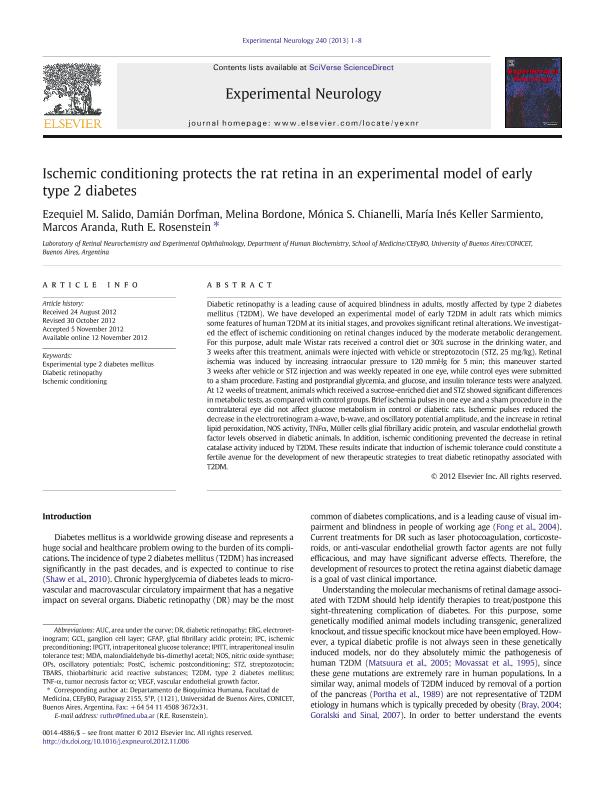Artículo
Ischemic conditioning protects the rat retina in an experimental model of early type 2 diabetes
Salido, Ezequiel Martin ; Dorfman, Damián
; Dorfman, Damián ; Bordone, Melina Paula
; Bordone, Melina Paula ; Chianelli, Monica Silvia
; Chianelli, Monica Silvia ; Keller Sarmiento, Maria Ines
; Keller Sarmiento, Maria Ines ; Aranda, Marcos; Rosenstein, Ruth Estela
; Aranda, Marcos; Rosenstein, Ruth Estela
 ; Dorfman, Damián
; Dorfman, Damián ; Bordone, Melina Paula
; Bordone, Melina Paula ; Chianelli, Monica Silvia
; Chianelli, Monica Silvia ; Keller Sarmiento, Maria Ines
; Keller Sarmiento, Maria Ines ; Aranda, Marcos; Rosenstein, Ruth Estela
; Aranda, Marcos; Rosenstein, Ruth Estela
Fecha de publicación:
02/2013
Editorial:
Elsevier
Revista:
Experimental Neurology
ISSN:
0014-4886
Idioma:
Inglés
Tipo de recurso:
Artículo publicado
Clasificación temática:
Resumen
Diabetic retinopathy is a leading cause of acquired blindness in adults, mostly affected by type 2 diabetes mellitus (T2DM). We have developed an experimental model of early T2DM in adult rats which mimics some features of human T2DM at its initial stages, and provokes significant retinal alterations. We investigated the effect of ischemic conditioning on retinal changes induced by the moderate metabolic derangement. For this purpose, adult male Wistar rats received a control diet or 30% sucrose in the drinking water, and 3 weeks after this treatment, animals were injected with vehicle or streptozotocin (STZ, 25 mg/kg). Retinal ischemia was induced by increasing intraocular pressure to 120 mmHg for 5 min; this maneuver started 3 weeks after vehicle or STZ injection and was weekly repeated in one eye, while control eyes were submitted to a sham procedure. Fasting and postprandial glycemia, and glucose, and insulin tolerance tests were analyzed. At 12 weeks of treatment, animals which received a sucrose-enriched diet and STZ showed significant differences in metabolic tests, as compared with control groups. Brief ischemia pulses in one eye and a sham procedure in the contralateral eye did not affect glucose metabolism in control or diabetic rats. Ischemic pulses reduced the decrease in the electroretinogram a-wave, b-wave, and oscillatory potential amplitude, and the increase in retinal lipid peroxidation, NOS activity, TNFα, Müller cells glial fibrillary acidic protein, and vascular endothelial growth factor levels observed in diabetic animals. In addition, ischemic conditioning prevented the decrease in retinal catalase activity induced by T2DM. These results indicate that induction of ischemic tolerance could constitute a fertile avenue for the development of new therapeutic strategies to treat diabetic retinopathy associated with T2DM.
Archivos asociados
Licencia
Identificadores
Colecciones
Articulos(CEFYBO)
Articulos de CENTRO DE ESTUDIOS FARMACOLOGICOS Y BOTANICOS
Articulos de CENTRO DE ESTUDIOS FARMACOLOGICOS Y BOTANICOS
Citación
Salido, Ezequiel Martin; Dorfman, Damián; Bordone, Melina Paula; Chianelli, Monica Silvia; Keller Sarmiento, Maria Ines; et al.; Ischemic conditioning protects the rat retina in an experimental model of early type 2 diabetes; Elsevier; Experimental Neurology; 240; 2-2013; 1-8
Compartir
Altmétricas



